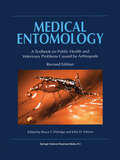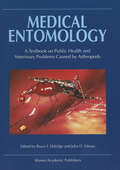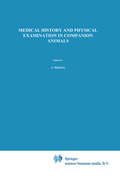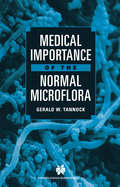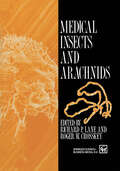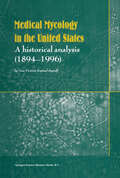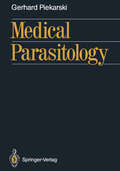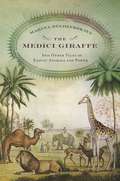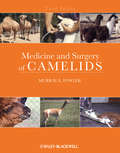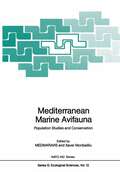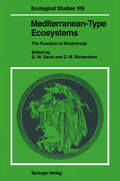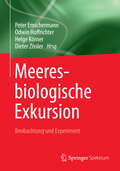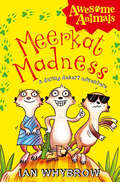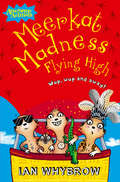- Table View
- List View
Medical Entomology: A Textbook on Public Health and Veterinary Problems Caused by Arthropods
by B. F. Eldridge J. D. EdmanMedical Entomology: A Textbook on Public Health and Veterinary Problems Caused by Arthropods
by Bruce F. Eldridge John D. EdmanMedical Entomology in Asia (Entomology Monographs)
by Kyoko Sawabe Chizu Sanjoba Yukiko HigaThis book presents the latest findings in medical entomology in Japan and neighboring Asian countries. It provides an overview of the current issues of medically important arthropods in this region and also refers to the issues that are likely to become more serious in the near future. It helps us understand that addressing the arthropod issues is not enough in limited regions, but requires a coordinated response throughout these regions. Global warming and globalization are affecting both vector and vector-borne diseases, causing rapid changes in their distribution and ecology. From the perspective of global pest control, the book focuses not only on domestic pests in Japan but also on pests in neighboring Asian countries including the Philippines, Thailand, Taiwan, Vietnam, etc., which are geographically and economically close to Japan. Japan has experience of eradicating malaria and lymphatic filariasis, drastically reducing the number of cases of Japanese encephalitis patients, and succeeded in controlling flies in the metropolis of Tokyo. The know-how learned and created from these past successes should provide valuable information for other parts of Asia that are still struggling with pest infestation today. With the growing interest in these issues worldwide, this book provides essential information in medical entomology for researchers, including students and early career researchers. By integrating the latest findings in medical entomology with past successes and experiences in the field, the book is also a valuable reference for many professionals planning sustainable pest control.
Medical History and Physical Examination in Companion Animals
by H. W. Vries A. Rijnberkcreation no falsification falsification Tl rejected creation etc. Figure 1-1 delivers such a result that the theory must be seen as an extension of Popper's rational proce discarded. In this way we come at the same time dure for theory elimination. to the border between science and nonscience: a Popper's naive falsifiability knows only one theory is scientific if it is falsifiable. It is thus way, the elimination of what is weak. The so not scientific to bring additional evidence to phisticated falsifiability, in contrast, knows only bear in vindication of the theory; the theory elimination in combination with the acceptance would thereby take on the character of an un of an alternative. According to sophisticated fal challengeable certainty of belief ('religion'). sifiability, a scientific theory T r is only aban Following Popper, others such as Kuhn, with doned if its place is taken by another theory T2 his paradigm theory, have considerably extended which has the following three characteristics: 1 the range of thought over what is scientific and T 2 has more empirical content than TI; the new what is not.
Medical Importance of the Normal Microflora
by Gerald W. TannockIt has been estimated that there are more microbial cells inhabiting the human body than there are eukaryotic cells of which it is made up. This normal microflora usually co-exists relatively peacefully with the host and does not cause infection. The mechanisms by which this co-existence is achieved are still not properly understood and the interaction between the normal microflora and the host is far from simple. For a variety of reasons, however, this interaction can be disturbed and often results in the microflora becoming pathogens. The study of the diseases then caused is important both in terms of treatment and in terms of contributing to our understanding of the mechanisms by which the normal microflora usually interacts with the host. This title brings together an international list of contributors, all of whom have active research interests in the normal microflora. Each of the chapters reviews current knowledge about a specific group or organism within the microflora and the diseases they can cause. Microflora of the skin, respiratory tract, oral cavity, gastrointestinal system and genital tract are all discussed and the impact of molecular methods on our understanding of the normal microflora is emphasised throughout the book. Medical microbiologists, dental specialists, infectious disease specialists, nutritionists and gastroenterologists will all find this book of immense interest and value, as will epidemiologists, dermatologists and general microbiologists.
Medical Insects and Arachnids
by R.P. Lane R.W. CrosskeySurprising though it seems, the world faces almost as great a threat today from arthropod-borne diseases as it did in the heady days of the 1950s when global eradication of such diseases by eliminating their vectors with synthetic insecticides, particularly DDT, seemed a real possibility. Malaria, for example, still causes tremendous morbidity and mortality throughout the world, especially in Africa. Knowledge of the biology of insect and arachnid disease vectors is arguably more important now than it has ever been. Biological research directed at the development of better methods of control becomes even more important in the light of the partial failure of many control schemes that are based on insecticide- although not all is gloom, since basic biological studies have contributed enormously to the outstanding success of international control programmes such as the vast Onchocerciasis Control Programme in West Africa. It is a sine qua non for proper understanding of the epidemiology and successful vector control of any human disease transmitted by an arthropod that all concerned with the problem - medical entomologist, parasitologist, field technician - have a good basic understanding of the arthropod's biology. Knowledge will be needed not only of its direct relationship to any parasite or pathogen that it transmits but also of its structure, its life history and its behaviour - in short, its natural history. Above all, it will be necessary to be sure that it is correctly identified.
Medical Management of Wildlife Species: A Guide for Veterinary Practitioners
by Sonia M. Hernandez Heather W. Barron Erica A. Miller Roberto F. Aguilar Michael J. YabsleyThis book offers an all-encompassing resource for reliable information on the medical management of wild birds, mammals, amphibians, and turtles. Focusing on the medical information relevant to the wildlife setting, it covers triage, emergency care, and other key considerations in handling, diagnosing, and treating wild animals. The book's population-based approach encourages practitioners to understand individual animal care within the broader context. Medical Management of Wildlife Species: A Guide for Practitioners begins with a brief summary of natural history, and introductory chapters address general topics such as pre-release conditioning, post-release monitoring, and legal issues associated with handling wildlife species. Species-specific chapters provide practical information on medical management, including the most prevalent concerns for each species and the epidemiology of infectious diseases. Provides a complete reference to handling, diagnosing, and treating wild species Covers the full range of North American wildlife Includes concepts that can be applied to species globally Emphasizes information relevant to the wildlife setting Focuses on individual medicine, firmly grounded within population medicine for a broader approach Targeted at wildlife veterinarians, veterinary clinicians that will be presented with wildlife, veterinary technicians, and wildlife rehabilitators Medical Management of Wildlife Species is a must-have addition to the bookshelf of wildlife veterinarians and any veterinarian seeing occasional wild animals, as well as wildlife biologists and researchers.
Medical Management of Wildlife Species: A Guide for Practitioners
by Sonia M. Hernandez Heather W. Barron Erica A. Miller Roberto F. Aguilar Michael J. YabsleyThis book offers an all-encompassing resource for reliable information on the medical management of wild birds, mammals, amphibians, and turtles. Focusing on the medical information relevant to the wildlife setting, it covers triage, emergency care, and other key considerations in handling, diagnosing, and treating wild animals. The book's population-based approach encourages practitioners to understand individual animal care within the broader context. Medical Management of Wildlife Species: A Guide for Practitioners begins with a brief summary of natural history, and introductory chapters address general topics such as pre-release conditioning, post-release monitoring, and legal issues associated with handling wildlife species. Species-specific chapters provide practical information on medical management, including the most prevalent concerns for each species and the epidemiology of infectious diseases. Provides a complete reference to handling, diagnosing, and treating wild species Covers the full range of North American wildlife Includes concepts that can be applied to species globally Emphasizes information relevant to the wildlife setting Focuses on individual medicine, firmly grounded within population medicine for a broader approach Targeted at wildlife veterinarians, veterinary clinicians that will be presented with wildlife, veterinary technicians, and wildlife rehabilitators Medical Management of Wildlife Species is a must-have addition to the bookshelf of wildlife veterinarians and any veterinarian seeing occasional wild animals, as well as wildlife biologists and researchers.
Medical Mathematics and Dosage Calculations for Veterinary Technicians
by Robert BillThis user-friendly guide to medical mathematics helps veterinary technician students develop the math skills required before going into the practice setting. New workbook format allows readers to practice problems right inside the book Covers math fundamentals, metric and non-metric conversions, dosing and concentration, IV drug infusion, prescriptions, and doctors' orders Offers step-by-step instructions for performing calculations Newly expanded to include calculation of constant rate infusions, dilutions, compounding, and anesthesia applications Features a full answer key and images from the book in PowerPoint for instructors on a companion website
Medical Mathematics and Dosage Calculations for Veterinary Technicians
by Robert BillThis user-friendly guide to medical mathematics helps veterinary technician students develop the math skills required before going into the practice setting. New workbook format allows readers to practice problems right inside the book Covers math fundamentals, metric and non-metric conversions, dosing and concentration, IV drug infusion, prescriptions, and doctors' orders Offers step-by-step instructions for performing calculations Newly expanded to include calculation of constant rate infusions, dilutions, compounding, and anesthesia applications Features a full answer key and images from the book in PowerPoint for instructors on a companion website
Medical Mycology in the United States: A Historical Analysis (1894–1996)
by Ana Victoria Espinell-IngroffMedical Parasitology
by Gerhard PiekarskiMedical Parasitology is primarily intended to be an illustrated textbook which provides a review ofthe most important species ofparasite which occur in man; their areas ofdistribution, morphology and development, the typical disease symptoms resulting from infection, epidemiology and also methods of detection and indications for therapy. The main emphasis is on the protozoan and helmin thic diseases; medical entomology has only been covered in connection with the epidemiology of the diseases described here. Parasites sometimes occur exclusively in man (anthropoparasites) and sometimes also in animals (anthropozoonotic parasites). The monoxenous species complete theirdevelopmentinmanorinoneanimalalone (Scheme I). Heteroxenousspecies, which include most of the medically important parasites, develop partly in man and partly in animals in the course of their life cycle. They may even be forced to infect different species so that they can continue their development. This may sometimes be associated with a digenesis, the larval development taking place in one intermediate (Scheme II ®) or in two different intermediate hosts (Scheme III ®, ©), andthesexuallymaturestagedevelopinginanotherhost, the so-called definitive host (Scheme III ®). The importance of the intermediate hosts can vary considerably (see below).
The Medici Giraffe: And Other Tales of Exotic Animals and Power
by Marina BelozerskayaA fascinating exploration, spanning two thousand years, of the central role exotic animals have played in war, diplomacy, and the pomp of rulers and luminaries.
Medicine and Surgery of Camelids: Llama, Alpaca, Vicuna, Guanaco
by Murray FowlerMedicine and Surgery of Camelids is the classic comprehensive reference on llamas, alpacas, vicunas, guanacos, and camels. With information on topics ranging from nutrition and management to infectious diseases and emergency care, this book provides information on the health and maintenance of these species. Updates to the Third Edition include new information on camels; full color throughout; significant revisions to the parentage verification, infectious diseases, anesthesia, restraint, and nutrition sections; and additional information on the alpaca genome. This is an essential resource for practicing veterinarians, zoo veterinarians, and veterinary students.
Medicine and Surgery of Camelids
by Andrew J. NiehausA thoroughly updated new edition of the classic veterinary reference In the newly revised Fourth Edition of Medicine and Surgery of Camelids, accomplished veterinary surgeon, Dr. Andrew J. Niehaus delivers a comprehensive reference to all aspects of camelid medicine and surgery. The book covers general husbandry, restraint, nutrition, diagnosis, anesthesia, surgery, and the treatment of specific diseases veterinarians are likely to encounter in camelid patients. Although the focus of the text remains on llamas and alpacas, camel-specific information has received more attention than in previous editions with a chapter dedicated to old-world camelids. The editor revitalizes the emphasis on evidence-based information and pathophysiology and draws on the experience of expert contributors to provide up-to-date and authoritative material on nutrition, internal medicine, and more. A classic text of veterinary medicine, this latest edition comes complete with high-quality color photographs and access to a companion website that offers supplementary resources. Readers will also find: A thorough introduction to the general biology and evolution of camelids, as well as their husbandry and handling Comprehensive explorations of camelid physical exams, diagnostics, anesthesia, pain management, and surgery Topical discussions arranged by body system including the integumentary system, the musculoskeletal system and multisystem disorders Chapters dedicated to camelid radiology, parasitology, and diagnostic clinical pathology In-depth examinations of camelid toxicology, neonatology, and congenital diseases Perfect for veterinary specialists and general practitioners, Medicine and Surgery of Camelids will also earn a place in the libraries of veterinary students and trainees with an interest in camelids.
Medicine and Surgery of Camelids
by Andrew J. NiehausA thoroughly updated new edition of the classic veterinary reference In the newly revised Fourth Edition of Medicine and Surgery of Camelids, accomplished veterinary surgeon, Dr. Andrew J. Niehaus delivers a comprehensive reference to all aspects of camelid medicine and surgery. The book covers general husbandry, restraint, nutrition, diagnosis, anesthesia, surgery, and the treatment of specific diseases veterinarians are likely to encounter in camelid patients. Although the focus of the text remains on llamas and alpacas, camel-specific information has received more attention than in previous editions with a chapter dedicated to old-world camelids. The editor revitalizes the emphasis on evidence-based information and pathophysiology and draws on the experience of expert contributors to provide up-to-date and authoritative material on nutrition, internal medicine, and more. A classic text of veterinary medicine, this latest edition comes complete with high-quality color photographs and access to a companion website that offers supplementary resources. Readers will also find: A thorough introduction to the general biology and evolution of camelids, as well as their husbandry and handling Comprehensive explorations of camelid physical exams, diagnostics, anesthesia, pain management, and surgery Topical discussions arranged by body system including the integumentary system, the musculoskeletal system and multisystem disorders Chapters dedicated to camelid radiology, parasitology, and diagnostic clinical pathology In-depth examinations of camelid toxicology, neonatology, and congenital diseases Perfect for veterinary specialists and general practitioners, Medicine and Surgery of Camelids will also earn a place in the libraries of veterinary students and trainees with an interest in camelids.
Medicine and Surgery of Tortoises and Turtles
by Stuart McArthur Roger Wilkinson Jean MeyerMedicine and Surgery of Tortoises and Turtles is an innovative and exciting new reference book on the management of chelonians. Covering everything from species identification to virus isolation techniques, it is an indispensable source of information for veterinary practitioners treating sick or injured chelonians and all those involved in captive chelonian care, chelonian conservation medicine, and scientific research. Written by leading chelonian veterinarians from around the world, this definitive book includes: Detailed sections on anatomy, physiology, husbandry, nutrition, diagnosis, diseases, anaesthesia, surgery, therapeutics and conservation. Over 1000 full-colour photographs, which take the reader through disease recognition, practical nursing, captive husbandry and common surgical conditions. Down-to-earth clinical information presented in a user-friendly format. Medicine and Surgery of Tortoises and Turtles is both a step-by-step photographic guide and a detailed source of clinical and scientific data. As well as this, it contains fascinating material that has never been published before, ensuring that it will become the primary chelonian reference book.
Medieval Cats: Claws, Paws and Kitties of Yore
by AuthorLook what the cat dragged in from the Middle Ages - a curious compendium of cats unlike any you've ever lapped up before. Medieval Cats is the purr-fect bedside companion for lonely cat people and cat-holics (not to be confused with Catholics, obviously) and hiss-terical to boot.For more than a millennium, between 500 and 1500 AD, a myriad of medieval manuscripts and artworks painted an unpretty picture of cats as nothing more than lazy, selfish, and vicious. (How dare they!) Centuries later, the legacy of these masterpieces live on, shining a bright light on the dark age of cats, and telling a brand-new story of their paw-some glory.From bum-licking to devil-tricking, cat-fighting to nip-dribbling, Medieval Cats is a claw-filled clowder of more than 200 glorious full-colour felines getting up to no good - and a whole lot more! - from ye olde times of yester yore.
Mediterranean Ecosystems: Structures and Processes
by F.M. Faranda L. Guglielmo G. SpezieThis volume reflects the present state of the study of the Mediterranean as carried out by the Italian scientific community. The multidisciplinary character of the papers creates different "transversal" reading and clustering possibilities that the informed reader is free to design and undertake autonomously.
Mediterranean Marine Avifauna: Population Studies and Conservation (Nato ASI Subseries G: #12)
by Medmaravis Xaver MonbailliuMay I first congratulate, inconditionally, the Association MEDMARAVIS for organizing this symposium and for inviting me re presenting the Sardinian Ministry of the Environment. I would like to assert that such initiatives help a great deal and in a concrete way, Heads of government departments in charge of land use and natural resources. At this first symposium of the Mediterranean Marine Avifau na I must congratulate the scientific faculty for proposing such an ample spectrum of high quality papers dealing with diverse parts of the Mediterranean and beyond. I am sure that their con tributions will further scientific research, will help to pro tect our environment and will lead, more especially, to the ma nagement and conservation of seabirds. To know in order to manage has often been said at this sym posium. In fact, it is not possible to manage thoughtfully and rationally the natural resources without knowing more profound ly how they function. This reasoning is also valid on a more ge neral scale: regional planning of human activities should not disregard the evaluation of the ecosystem.
Mediterranean-Type Ecosystems: The Function of Biodiversity (Ecological Studies #109)
by George W. Davis David M. RichardsonHuman activities are causing species extinctions at a rate and magnitude rivaling those of past geologic extinction events. Exploring mediterranean-type ecosystems - the Mediterranean Basin, California, Chile, Australia, and South Africa - this volume addresses the question whether biological diversity plays a significant role in the functioning of natural ecosystems, and to what extent that diversity can be reduced without causing system malfunction. Comparative studies in ecosystems that are similar in certain respects, but differ in others, offer considerable scope for gaining new insights into the links between biodiversity and ecosystem functioning.
Meeresbiologische Exkursion: Beobachtung und Experiment
by Peter Emschermann Odwin Hoffrichter Helge Körner Dieter ZisslerMeeresbiologische Exkursionen sind besondere Höhepunkte des Biologiestudiums, weil Studenten bei kaum einer anderen Gelegenheit die überwältigende Formenmannigfaltigkeit der Organismen so unmittelbar lebend kennenlernen können.47 Meeresbiologen aus Deutschland, Frankreich, Großbritannien und Österreich haben aus ihrem Erfahrungsschatz 60 faunistische und floristische, ökophysiologische und ethologische Versuche zusammengetragen, die jeweils eine geschlossene Einheit mit Anleitung, Material und Literaturangaben darstellen. Die Gliederung folgt den drei Lebensgemeinschaften Benthos, Plankton und Nekton.Dieses Buch soll Exkursionsleitern und –teilnehmern dazu dienen, Exkursionen an Nordsee, Atlantik und Mittelmeer vorzubereiten, durchzuführen und auszuwerten, wozu auch die Anschriften und Hinweise über die Ausstattung der großen meeresbiologischen Stationen beitragen.
Meerkat Madness (Awesome Animals)
by Ian WhybrowThe first book in the hilarious Awesome Animals series – awesome adventures with the wildest wildlife. Told in Ian Whybrow’s unique style, this hilarious animal adventure starring ever-popular meerkats is a funny, fast-paced, sure-fire hit.
Meerkat Madness Flying High (Awesome Animals)
by Ian WhybrowThe first animal in the hilarious Awesome Animals series – awesome adventures with the wildest wildlife. The third Meerkat Madness book in the hilarious Awesome Animals series – awesome adventures with the wildest wildlife.
Meerkat Madness (Awesome Animals Ser.)
by Ian Whybrow Sam HearnThe first book in the hilarious Awesome Animals series – awesome adventures with the wildest wildlife. Told in Ian Whybrow’s unique style, this hilarious animal adventure starring ever-popular meerkats is a funny, fast-paced, sure-fire hit. Meerkat Madness is the story of a burrow of meerkat pups and their eccentric babysitter, Uncle Fearless who once travelled to the Blah-Blah camp at the edge of the desert. Truth be told, Uncle is a bit of a show-off but the pups love his colourful stories even if they don’t really believe them. But then they find a mysterious object buried in the sand and it isn’t long before they are caught up in a daring adventure of their own! A hilarious story about ever-endearing meerkats from the creator of Harry and the Bucketful of Dinosaurs.
